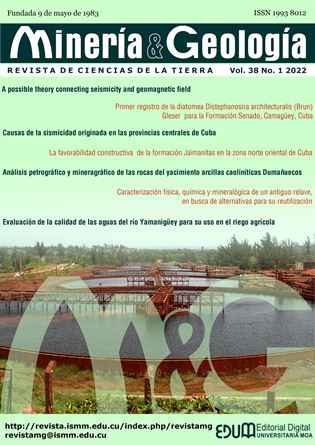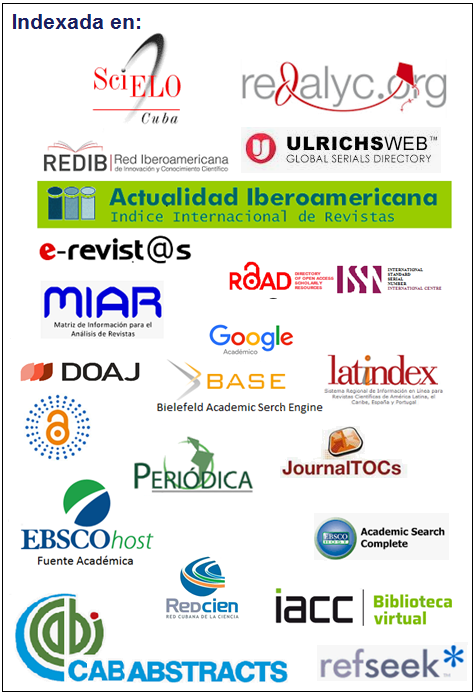A possible theory connecting seismicity and geomagnetic field
Palabras clave:
geomagnetic field, earthquake, electric circuit, global atmosphere, Earth´s conductivity response, earthquake hourly distribution.Resumen
A possible theory connecting geomagnetic field and earthquakes is presented. It was performed several hourly earthquakes distributions for different part of the world to explain, why bay-shape hourly distribution are clear for some areas, but not for others. In this sense, it was observed that earthquakes located in the intertropical zone reveal bay-shape earthquake distribution, but not defined shape is found for earthquakes outside the tropic. The answer is given based on geomagnetic flow orientation. The angle between the geomagnetic field direction and the Earth’s surface is almost parallel in the equator and orthogonal in the poles. Furthermore, considering the Laplace’s force law, the force experienced in the electrical conductor, in presence of magnetic field, is maximum when the angle between the magnetic flow direction and the electrical conductor is 90 degrees. Here, the electrical conductor is found on the global atmospheric electric circuit, where electrical current is flowing orthogonal to the Earth’s surface. The intertropical zone has angles between the geomagnetic flow vector and electric conductor more close to 90 degrees than middle latitudes and polar areas. The hourly earthquake distribution is modelled by the time-varying electrical potential in the global atmospheric electrical circuit, which is more significant in the intertropical zone. The effect of electricity on earthquakes is based on reverse piezoelectric phenomena.Descargas
Citas
Duma, G. and Vilardo, G. 1998. Seismicity Cycles in the Mt. Vesuvius Area and their Relation to Solar Flux and the Variations of the Earth’s Magnetic Field. Phys. Chem. Earth, 23(9-10): 927-931. https://doi.org/10.1016/S0079-1946(98)00121-9
Eccles, D., Sammonds, P.R. and Clint, O.C. 2005. Laboratory studies of electrical potential during rock failure. International Journal of Rock Mechanics & Mining Sciences, 42: 933-949. https://doi.org/10.1016/j.ijrmms.2005.05.018
Fujii, I. and Schultz, A. 2002. The 3D electromagnetic response of the Earth to ring current and auroral oval excitation. Geophys. J. Int., 151: 689–709. https://doi.org/10.1046/j.1365-246X.2002.01775.x
Gao, Y., Chen, X., Hu, H., Wen, J., Tang, J. and Fang, G. 2014. Induced electromagnetic field by seismic waves in Earth´s magnetic field. J. Geophys. Res. Solid Earth, 119 :5651-5685. https://doi.org/10.1002/2014JB010962
Johnston, M.J.S. 2002. Electromagnetic Fields Generated by Earthquakes. In: Lee, W., Jennings, P., Kisslinger, C., Kanamori, H., (Eds.), International Handbook of Earthquake and Engineering Seismology Part A Vol. 81, Elsevier, San Diego, pp. 621-635. https://doi.org/10.1016/S0074-6142(02)80241-8
Klein, F.W. 1976. Earthquake Swarms and the Semidiurnal Solid Earth Tide. Geophys. J. R. astr. Soc., 45: 245-295. https://doi.org/10.1111/j.1365-246X.1976.tb00326.x
Lei, Y., Jiao, L. and Chen, H. 2018. Possible correlation between the vertical component of lithospheric magnetic field and continental seismicity. Earth, Planets and Space, 70(179):1-19. https://doi.org/10.1186/s40623-018-0949-7
Marchitelli, V., Harabaglia, P., Troise, C. and De Natale, G. 2020. On the correlation between solar activity and large earthquake worldwide. Scientific Reports 10 (11495). https://doi.org/10.1038/s41598-020-67860-3
Moreno, B. and Calais, E. 2021. Evidence of correlation between high frequency geomagnetic variations and seismicity in the Caribbean. Open Journal of Earthquake Research, 10:30-41. https://doi.org/10.4236/ojer.2021.102003
Rycroft, M.J., Israelsson, S. and Price, C. 2000. The global atmospheric electric circuit, solar activity and climate change. Journal of Atmospheric and Solar-Terrestrial Physics, 62 (17-18):1563-1576. https://doi.org/10.1016/S1364-6826(00)00112-7
Sorokin, V.M., Chmyrev, V.M. and Hayakawa, M. 2020. A Review on Electrodynamic Influence of Atmospheric Processes to the Ionosphere. Open Journal of Earthquake Research, 9:113-141. https://doi.org/10.4236/ojer.2020.92008
Urata, N., Duma,G. and Freund, F. 2018. Geomagnetic Kp Index and Earthquakes. Open Journal of Earthquake Research, 7:39-52. https://doi.org/10.4236/ojer.2018.71003
Williams, E.R. 2009. The global electrical circuit: A review. Atmospheric Research, 91:140-152. http://dx.doi.org/10.1016/j.atmosres.2008.05.018
Publicado
Cómo citar
Número
Sección
Derechos de autor 2022 Bladimir Moreno Toirán

Esta obra está bajo una licencia internacional Creative Commons Atribución-NoComercial 4.0.
Los autores que publican en esta revista están de acuerdo con los siguientes términos:
- Licencia Creative Commons Atribución-NoComercial permite que el beneficiario de la licencia tenga el derecho de copiar, distribuir, exhibir y representar la obra y hacer obras derivadas para fines no comerciales siempre y cuando reconozca y cite la obra de la forma especificada por el autor o el licenciante.
- Los autores pueden establecer por separado acuerdos adicionales para la distribución no exclusiva de la versión de la obra publicada en la revista (por ejemplo, situarlo en un repositorio institucional o publicarlo en un libro), con un reconocimiento de su publicación inicial en esta revista.
- Se permite y se anima a los autores a difundir sus trabajos electrónicamente (por ejemplo, en repositorios institucionales o en su propio sitio web) antes y durante el proceso de envío, ya que puede dar lugar a intercambios productivos, así como a una citación más temprana y mayor de los trabajos publicados (Véase The Effect of Open Access) (en inglés).
- Lo anterior debe realizarse siempre sobre el artículo ya publicado por Minería y Geología.
La revista permite que los autores tengan los derechos de autor sin restricciones
La revista permite que los autores conserven los derechos de publicación sin restricciones




